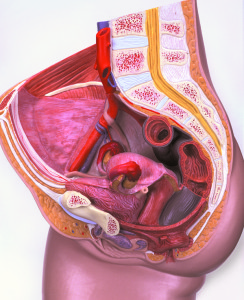Pelvic Floor Physio & Rehab
Pelvic Floor physiotherapy is the assessment and treatment of the pelvis and its surrounding and associated structures.
Your Pelvic Floor
The Pelvic floor is the network of muscles, fascia and ligaments that provide a ‘hammock like’ support system to your vagina and pelvic organs (bladder, uterus and bowel). During lifting, exercising or coughing the pelvic floor tightens and lifts muscles and sphincters around the pelvic organs.
Pelvic Floor Function:
• Support and lift your pelvic organs and vagina to prevent pelvic organ prolapse/descent
• Support the growing baby and uterus
• Assist with bladder and bowel control
• Increase sexual function
• Provide support and prevent leaking during: high impact activities (such as skipping/running); sustained postures (such as, carrying your baby), and; activities that suddenly increase intra-abdominal pressure (such as laughing, sneezing and coughing).
• Provide Spinal stability. This occurs when the pelvic floor correctly co-contracts with the deep core muscles (transversus abdominis and multifidus) and the diaphragm. Assisting in preventing injury and/or reducing pain and dysfunction of the low back and pelvis. Improving alignment, mobility and function.
Causes of Pelvic Floor Dysfunction
Pelvic floor muscle dysfunction can be derived from a number of damaging factors, such as: excessive habitual use of the superficial abdominal muscles; incorrect posture or breathing patterns; chronic or constant coughing; excessive abdominal work outs; over challenging exercise (such as returning to high impact activities too early post partum); poor bladder and bowel habits; dietary habits; Tight muscles that are unable to relax or weak pelvic floor muscles, both of which affect the ability to lift and support the pelvic organs. These factors put you at risk of a Pelvic Floor Prolapse with eventual loss of bladder control (leaking of urine) and/or low back and pelvic girdle dysfunction and pain.
Pelvic Floor Conditions commonly treated (listed alphabetically):
• Bladder Control/ Urinary Incontinence
• Bowel Constipation/Faecal Incontinence
• Coccydynia (Tailbone Pain)
• Core muscle re-strengthening and co-ordination training
• Exercise Prescription
• Low Back Pain
• Painful Intercourse/Dyspareunia
• Pelvic girdle pain (e.g., hips, pubic symphysis, sacrum, coccyx, SI joint dysfunction)
• Pelvic Organ Prolapse
• Perinatal Health
• Prenatal and Postpartum health/rehabilitation
• Rectus Diastasis
• Scar Tissue Release/Mobilization (post C section/Episiotomy/Tear)
• Vaginismus (vaginal tension causing a number of symptoms)
• Vestibulodynia (chronic pain of the vulvar area)
• Vestibulitis
• Vulvodynia (burning pain of the vulva, including the vaginal opening)
How we can assist you in your rehabilitation
In order to determine the root of your dysfunction/condition and the possible causes associated; we undertake a thorough history, listen carefully to the messages that the client and their bodies offer, and perform a comprehensive physical examination (externally, and when indicated; internally). This allows the physiotherapist to ascertain an effective treatment plan that encompasses the client goals and their well-being. We then use a variety of treatment techniques (please see, services provided) to correct alignment, joint and tissue mobility, movement and function. We can assist you to continue this restored balance by providing you with self-management strategies and progressive, therapeutic exercise. Advise you on when it is suitable to return to certain activities (such as running, skipping, jumping), post partum.
Pelvic Floor Success
The success of your pelvic floor rehabilitation is founded on correct postural alignment, breathing strategies and an effective pelvic floor contraction and relaxation. It is paramount that we establish your individual pelvic floor muscle cue so that you can correctly activate and relax your pelvic floor muscles effectively and safely. Our aim is to restore your pelvic floor health through education in self-management to eliminate poor habits or elements contributing to your condition. We work on correct alignment and breathing techniques to prescribe progressive therapeutic exercises and encourage an appropriate and active lifestyle.
 Kar Morgan | Evergreen Physiotherapy & Wellness
Kar Morgan | Evergreen Physiotherapy & Wellness
